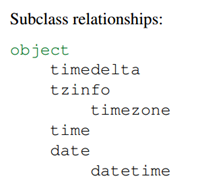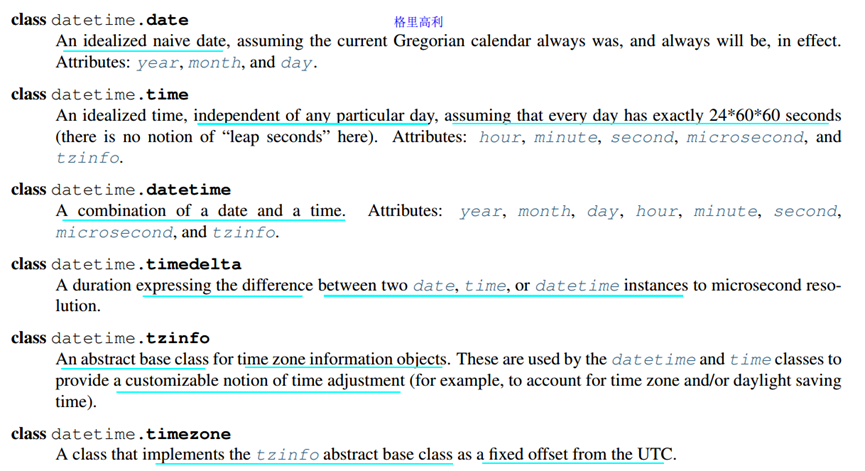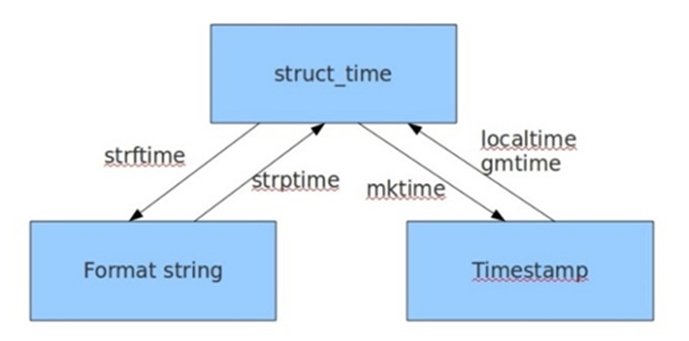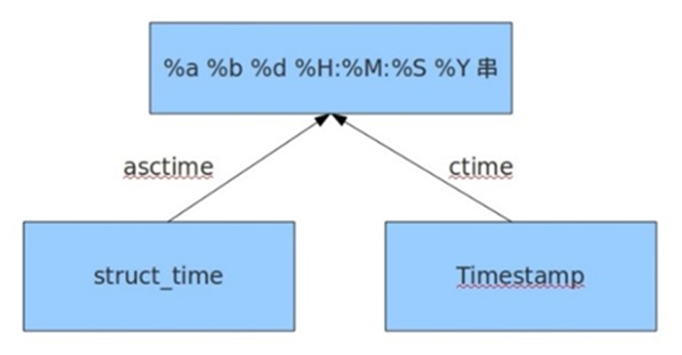datetime模块
简介
在python参考手册8.1节
There are two kindsof date and time objects: “naive”and “aware”
An aware object has sufficient knowledge of applicable algorithmic and politicaltime adjustments to locate itself relative to other aware objects
A naive object does not contain enough information to unambiguouslylocate itself relative to other date/time objects
Datatime模块包含如下的子类

Available Types

A date object represents a date (year, month and day) in an idealized calendar, the current Gregorian calendarindefinitely extended in both directions
A time object represents a (local) time of day, independent of any particular day
A datetime object is a single object containing all the information from a date object and atime object.
Like a date object, datetime assumes thecurrent Gregorian calendar extended in both directions
Like a time object,datetime assumes thereare exactly 3600*24 seconds in every day
3种表示时间方式
1)时间戳
2)格式化的时间字符串
3)元组(struct_time)共九个元素
date类
__str__():返回日期的字符串;
ctime():返回ctime格式的字符串;
__format__(...):返回指定格式的日期字符串;
strftime(...):返回指定格式的日期字符串,与方法3等价
a = datetime.date(2018, 6, 19)
a
-- > datetime.date(2018, 6, 19)
a.__str__()
-- > '2018-06-19'
a.ctime()
-- > 'Tue Jun 19 00:00:00 2018'
a.__format__('%Y/%m/%d')
-- > '2018/06/19’
a.strftime('%Y-%m-%d')
-- > '2018-06-19'time类
__str__():返回时间的字符串;
isoformat():返回符合ISO标准的时间字符串;
__format__(..):返回指定格式的时间字符串;
strftime(...):返回指定格式的时间字符串,与方法3等价
a = datetime.time(12,20,59,899)
a
datetime.time(12, 20, 59, 899)
a.__str__()
-- > '12:20:59.000899'
a.isoformat()
-- > '12:20:59.000899'
a.strftime('%H:%M:%S')
-- > '12:20:59'
a.__format__('%H:%M:%S')
-- > '12:20:59'
datetime类
可以看做是date类和time类的合体,大部分的方法和属性都继承于这2个类,其数据构成也是由这2个类的所有属性构成
now():返回当前日期时间的datetime对象;
date():返回datetime对象的日期部分;
time():返回datetime对象的时间部分;
utcnow():返回当前日期时间的UTC的datetime对象;
__str__():返回日期的字符串;
ctime():返回ctime格式的字符串;
__format__(...):返回指定格式的日期字符串;
strftime(...):返回指定格式的日期字符串,与方法3等价
timedelta类
· 类构成:计算2个datetime对象的差值;
· 有7个可选参数,默认值为0:datetime.timedelta(weeks=0,days=0, hours=0, minutes=0, second=0, microsecond=0, milliseconas=0);
str(t) | Returns a string in the form [D day[s], ][H]H:MM:SS[.UUUUUU], where D is negative for negative t. (5) |
repr(t) | Returns a string in the form datetime.timedelta(D[, S[, U]]), where D is negative for negative t. (5) |
time模块
在python参考手册16.3节
注意datetime模块中time类与time模块不是一个概念
得到struct_time的函数:time.localtime()
得到timestamp的函数:time.time()
得到format string time的函数:time.asctime()或time.ctime()
time类的转化函数如下,下面都是time类的类成员函数:
方法一:

方法二:
上面的是24字符时间,例如“TueDec 11 18:07:14 2008”,与上面的Format string是不同的,Format string可以自己定义格式;

struct_time转24字符:
import time
time.asctime(time.localtime())
timestamp转24字符:
import time
asctime(localtime(secs))
datetime模块中datetime和time模块中的转化
可以通过字符串相互转化
python中计算运行时间
方法1
import datetime
starttime = datetime.datetime.now()
#long running
endtime = datetime.datetime.now()
print (endtime - starttime).seconds
方法 2
start = time.time()
run_fun()
end = time.time()
print end-start
方法3
start = time.clock()
run_fun()
end = time.clock()
print end-start方法1和方法2都包含了其他程序使用CPU的时间,是程序开始到程序结束的运行时间。
方法3算只计算了程序运行的CPU时间
方法4
start = time.perf_counter()
run_fun()
end = time.perf_counter()
print end-start
方法5
start = time.process_counter()
run_fun()
end = time.process_counter()
print end-start






















 220
220











 被折叠的 条评论
为什么被折叠?
被折叠的 条评论
为什么被折叠?










